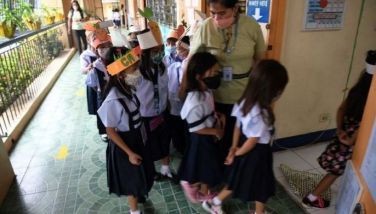4 M Pinoy kids engaged in child labor – study
June 13, 2006 | 12:00am
 There are four million child laborers in the Philippines and 2.8 million of them are employed in dangerous jobs, a recent study by the National Coalition Against Child Labor revealed yesterday.
There are four million child laborers in the Philippines and 2.8 million of them are employed in dangerous jobs, a recent study by the National Coalition Against Child Labor revealed yesterday.
The coalition also said its study showed that worldwide, about 246 million children aged 5 to 17 — one out of six children are involved in child labor.
The study said that 171 million of this total number — one out of eight child laborers — are involved in hazardous forms of employment.
In line with the celebration of the 108th Philippine Independence Day and the World Day Against Child Labor yesterday, the National Coalition Against Child Labor in Commercial Agriculture (NCACLCA) urged Filipinos to help in eradicating cases of child labor in the country.
The coalition, its secretariat at the Kamalayan Development Foundation, launched a nationwide campaign of awareness, advocacy and mobilization to fight the massive exploitation of children and their exposure to deadly pesticides in most commercial farms in the Philippines.
Participants from different parts of the country, most of them child laborers, marched from the Philippine Social Science Center Building in Commonwealth Avenue and proceeded to the Quezon City Memorial Circle to hold a forum on the issue.
Kamalayan Development Foundation executive director Alejandro Apit said a majority of the children working in the Philippines are involved in commercial child labor.
Apit said the Kamalayan foundation had exposed the problem of child labor in the country as early as 1993.
Among the worst forms of child labor in the country were mining and quarrying, deep-sea fishing, pyrotechnics manufacturing, prostitution and pornography, domestic work and commercial agriculture.
Apit said about 2.1 million of the 2.8 million child laborers in the country were working in commercial agriculture.
He said most of those in commercial agriculture were exposed to pesticides used by farms to remain competitive in the world market.
Apit said the constant exposure of children to pesticides has led to various serious illnesses, particularly cancer.
In 2002, the International Labor Organization (ILO) chose June 12 as the world day against child labor.
In 2003, the ILO focused on cases of child trafficking, child domestic labor in 2004, and children in mining and quarrying in 2005 but this year the ILO has not issued a particular focus for child labor activism, the NCACLCA said.
The World Day against Child Labor was also commemorated in the cities of Ormoc, Bacolod and Davao.
Apit said most of the children involved in commercial agriculture were based in Davao City.
BrandSpace Articles
<
>
- Latest
Latest
Latest
December 14, 2024 - 11:22am
By Karry Sison | December 14, 2024 - 11:22am
December 9, 2024 - 2:53pm
By Rupert Paul Manhit | December 9, 2024 - 2:53pm
December 8, 2024 - 9:00am
By Jing Castañeda | December 8, 2024 - 9:00am
November 30, 2024 - 5:19pm
By Joanna Perfecto | November 30, 2024 - 5:19pm
November 23, 2024 - 6:23pm
By Rupert Paul Manhit | November 23, 2024 - 6:23pm
November 23, 2024 - 1:52pm
By Edilberto de Jesus | November 23, 2024 - 1:52pm
Recommended




























